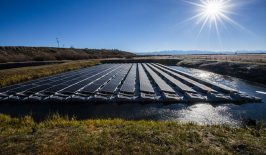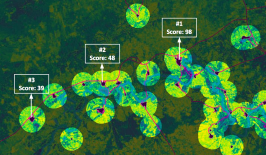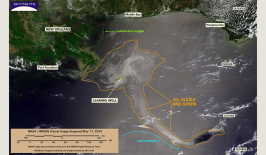Satellites deliver crucial information about the health of our planet. Measurements they provide help us forecast changes in climate, ensure sustainable fishing practices, increase environmental protection and monitor our rising seas. They also provide crucial services, such as navigation, telecom and broadcasting, used by everyone, every day. At the same time, our space missions themselves, at every stage of their design and execution, can also have a negative ecological impact on our planet – and can pollute outer space too. And the issue of space junk is only one factor.
Increasingly, national laws are coming into force to protect the environment here on Earth, and ESA has begun taking steps to reduce the impact of its activities on both the Earth and space. In 2012, the Agency established the Clean Space initiative and, in the hope that other agencies will follow their lead, the Agency is creating and adopting new approaches to spacecraft design and technology with the aim of fielding cleaner alternatives to reduce the environmental impact of spaceflight.

We spoke with Luisa Innocenti, who has led the Clean Space Office since its inception in 2012, about the challenges and opportunities of sustainable aspects of space, various tools and technologies that help make space missions greener, and the striking similarity between clean space tech and climate change. © ESA
Could you tell us a bit about the Clean Space initiative?
The Clean Space initiative was set up to evaluate and possibly mitigate the impact of space activity on the environment. When we talk about the environment and emissions due to space flight, there are two different zones: there is Earth all the way up to the top of atmosphere, and then there is space, above the atmosphere. Because of this, we divide our Clean Space efforts into three different topics.
The first is ‘ecodesign’ for satellites and rockets and includes the development of non-toxic technologies. These aim to decrease any environmental impact up to the top of atmosphere. To do this, we are using a tool called ‘life-cycle assessment’, or LCA. It means making a thorough, ‘cradle-to-grave’ assessment of environmental impacts associated with all the stages of a mission’s life. This tool used in other domains, too, not just space.
The main issue is that when we tried to use LCA to evaluate the environmental impact of a satellite, we discovered that spaceflight is highly specialised and we had to really work to understand many of the scientific and engineering factors involved. For example, with satellites and rockets, we use strange, exotic materials. We use them in a strange way. And what is the environmental impact of testing a satellite prior to its flight? This sort of basic information is neither known nor widely available. We needed to go back and start researching that information and we are still only part of the way through that process.
The second topic for Clean Space is ‘management of end of life’. Just like we have polluted the ground here on Earth, we have polluted orbits around Earth. How did this happen? For several reasons, mostly similar to why we have polluted Earth’s land and seas – we thought that the oceans were infinite. We threw things away and because they are only small, we thought there would be no impact. Except that, we have kept doing it and now our oceans are filling up with plastic. No one thought this would happen and in space, we have done precisely the same with our dead and discarded satellites up above. We didn’t consider ‘end-of-life management’, for example, for plastics here on Earth, and starting in the 1960s with the first space flights, we didn’t do it with satellites either.
Further, it is very difficult and costly to go to space. So from the start, all spacefaring nations and their national agencies were very concerned about getting there safely and effectively, and no one thought about what we were going to do afterwards – and we abandoned things – satellites, rocket bodies, upper stages, discarded bits like optical instrument covers. Now there is awareness about this issue, there are guidelines to say what you should not do. For spacecraft operators, however, all this represents a cost, because sometimes to better manage a satellite’s end of life, you need to redesign the fuel tank, to have more propellant on board, or add a ‘passivation valve’. All of this adds cost to a spacecraft. (Editor’s note: A passivation valve is activated at the end of a mission to vent all the remaining propellant and reduce the risk of a spacecraft explosion.)
And not only that. When you go to space, it’s not as if engineers simply say, “Okay, just put this new widget on board.” No! Designers and engineers have to confirm, “Is this new technology or is this new process qualified for spaceflight?” “Will it work reliably in space?” New technologies all have to be qualified on ground before flight and doing so is a costly, years-long process. Yes, a fuel tank which is ‘designed to demise’ – that will completely burn up during re-entry into Earth’s atmosphere – costs about the same to produce as a traditional fuel tank. Nevertheless, it will cost more because it has to be newly qualified for use in space. That is definitely a role that a public agency like ESA should have – working together with European industry to develop and qualify those basic technologies that will help make missions cleaner.
The third topic we’re looking at is called ‘in-orbit servicing’, and it refers to a large portfolio of new technologies that can be used to extend the life of satellites in space, like refuelling them, replacing broken components, ‘tugging’ them to new and more useful orbits. If we can get more useful life out of a mission, then we do not have to launch a replacement so soon. These technologies can be applied, for example, to the challenge of grabbing onto a dead satellite and performing a controlled de-orbit manoeuvre. ‘Active debris removal’ is key to removing mass from orbit, which is what we need to do to reduce the overall quantity of space debris.
Across the international space sector, everybody is looking at debris removal. At ESA, our ‘rock star’ mission is called ClearSpace-1, which will fly in 2025. It is a fantastic mission. Never done before and extremely difficult. ClearSpace-1 aims to remove an ESA-owned item from orbit.
(Editor’s note: In 2025, this mission will remove a large piece of space debris using a claw-equipped spacecraft with four arms. After grabbing it during orbit, the spacecraft will then conduct a controlled reentry, safely burning up in atmosphere.)
Why ESA debris? The point is that when any satellite stops working, the launching state still has responsibility over that, over the debris, and therefore it is easier to clean your own debris than to ask permission from somebody else. We have to see how all these cleaning up operations – deorbiting debris – are going to work. It is stupid if we clean up space now and then, tomorrow we abandon another satellite. The management of end of life is, to me, even more important than active debris removal.
Was the Clean Space initiative developed by ESA? Or was it a directive from the EU?
It was not an EU initiative. It was really ESA thinking about it. The only guidelines that existed at the time were International Organization for Standardization standards. The ISO standard said that at the end of the life of a satellite, you need to remove your satellite from protected orbits within 25 years. You need to passivate the satellite, meaning you need to disconnect the battery and vent the tanks so that the satellite does not explode. Those standards were already there, but they were not applied in a serious way. They are guidelines, not laws; you can always ask for a waiver, and your own Agency or government spaceflight regulator can give you a waiver.
Therefore, this initiative is an example of self-regulation?
Yes, because when we proposed this, we said, we are a public scientific European Agency. It is our duty and it is our moral mandate to protect the environment because we are public, because we are scientific and because we are European. The environment is a strong European vision.
Therefore, we were saying we should be on the forefront; we should set an example to everybody else. Because when it comes to cleaning up space debris, there is still a lot of discussion about why we should do it at all. It is costly and difficult. What we need first are agreed regulations. However, if we set an example, if we can prove that it can be done, at least we take away the part where people say, “It cannot be done.” I do not know whether we will manage to do it or not. It is a very difficult mission, but it is the right thing to do. People will tell you that it is an impossible mission. But Rosetta was an impossible mission too and we did it. When humans went to the Moon, it was impossible and we did it. So, in reality, nothing is impossible. It simply comes down to – how much money do we want to invest in it?
One aspect that you mentioned is life-cycle assessment. How can satellites be made more sustainable throughout their life cycle?
The first thing to understand is that there are what we call ‘hotspots’ – a point in a process or technology that pollutes more than others. You might be surprised, but one of the biggest hotspots that we found when we were looking at the whole space flight process was the energy used for the clean rooms. (Editor’s note: clean rooms are the ultra dust- and contaminant-free facilities in which satellites and rockets are built, assembled and tested).
In addition, building satellites needs work spaces that are highly controlled in terms of temperature, but heating and cooling air is something that uses a lot of energy. So you have two options: One is to use green energy for the air conditioning and the air filtering and cleaning, or, two, can we think: “Do we really need those clean rooms at all?” Can we come up with an innovative new way to build spacecraft that does not need traditional, energy intensive clean rooms and other facilities?
Then there are other examples. For example, in space, surfaces have to be very clean. There was a solution, a chemical, that we were using to clean steel, which we found out was actually a polluting agent. So we investigated to see if we could use citric acid, which is basically harmless, instead. We had to check if surfaces treated with citric acid were still okay over time – if they still had the properties we needed. First, because if I clean a satellite, or an optical surface, today, from the moment I clean it to the moment I launch it, anything from six months to a year could go by. Second, after it is launched, it will be in space for ten years, so I need to be sure that the cleaned surface will perform well in the long term.
Therefore, life-cycle assessment comprises looking at many small actions. There is no one single obvious thing. It is many small details together.
It’s interesting what you mentioned about there being many people who prefer to do things in more traditional ways because those ways work and then you don’t need to do the research that innovation requires. Is that a problem you often see?
It is a problem of space flight and its enormous costs. The space sector is seen as extremely innovative, but it is actually only slowly innovative. It takes a long time to get some technology qualified for launch. When I joined ESA 30 years ago, people were talking about electric propulsion. It took 20 years before we had the first satellite with electric propulsion. No one wants to risk a multi-million-euro mission on a technology that is unproven – the cost to go to space is very high that you cannot afford to fail. So, yes, the space domain is innovative, but it is slow innovation.
Talking about these more sustainable practices or sustainable materials that could be used in satellites: What do you see as the main barriers to them becoming the norm? Is it money? Is it peoples’ opinion? People don’t think it’s important? Or is it technical – or a combination?
It is all of it in a way, from the point of view that, as I said, money is important because the story of getting technology qualified for space is very important. Everything needs to be qualified, and that is something that is especially true for space engineering. We have ‘technology readiness levels’, or TRL. It is necessary to have achieved the necessary TRL in order for something to be taken on board – and in order to reach the proper TRL, you need to invest because you need to test how it will react and function in space.
So money is one thing, but it is not only money, because if we invested all of our money into making space flight cleaner, maybe we would already be far ahead. It is also a question of focus for society. The fact is, there is a lot of money being invested today in making access to space cheaper. If we invest the money we have on making it cheaper, you might not be investing in making it cleaner. We can do both, and make space flight cleaner for all of us.
This article is part of the RESET Special Feature “Satellites for Sustainable Development”. Follow the link to explore all of the articles in the series.










